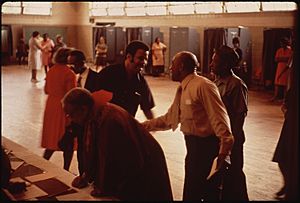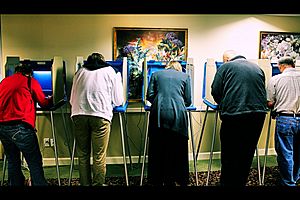Timeline of voting rights in the United States facts for kids
This is a timeline about voting rights in the United States. It shows important moments when different groups of people in the U.S. gained the right to vote. It also shows times when people lost their right to vote, which is called disenfranchisement. Understanding who can vote and when is a big part of American history!
Contents
- Early Voting Rights (18th Century)
- Voting Rights in the 19th Century
- Voting Rights in the 20th Century
- Early 1900s (1900s)
- Women's Suffrage Movement (1910s)
- Women's Right to Vote and Native American Citizenship (1920s)
- Court Cases and Poll Taxes (1930s)
- More Citizenship and Voting Rights (1940s)
- Expanding Rights and Removing Barriers (1950s)
- Major Civil Rights Era Changes (1960s)
- Lowering the Voting Age and More Protections (1970s)
- Extending Protections (1980s)
- Making Registration Easier (1990s)
- Voting Rights in the 21st Century
Early Voting Rights (18th Century)
Voting Rules Begin (1780s)
1789
- The Constitution of the United States was written. It gave each state the power to decide who could vote.
- At first, most states only let white men who owned property or paid taxes vote. This was only about 6% of all people!
- Some states were different. New Jersey, for example, allowed unmarried and widowed women to vote, no matter their race. But married women couldn't own property, so they usually couldn't vote.
- Georgia removed the rule about owning property to vote.
More Changes (1790s)
1790
- The Naturalization Act of 1790 said that free white people born outside the U.S. could become citizens. But this law didn't automatically give them the right to vote. States still made their own rules.
1791
- Vermont became a new state. It allowed all men to vote, no matter their race or if they owned property.
1792
- New Hampshire stopped requiring people to own property to vote.
- Kentucky became a new state. It allowed free men to vote, no matter their race or if they owned property. However, most Black people in Kentucky were enslaved and couldn't vote. Later, free Black people also lost their voting rights there.
- Delaware removed the property rule but still required people to pay taxes to vote.
1798
- Georgia removed the tax requirement for voting.
Voting Rights in the 19th Century
Loss of Rights (1800s)
1807
- In New Jersey, free Black men and all women lost their right to vote.
Expanding Rights for White Men (1820s)
1821
- New York changed its rules. White men no longer needed to own property to vote.
- However, Black men in New York now needed to own $250 worth of property to vote. This was a very high amount.
- Even though slavery was ending in New York, this rule made it hard for free Black people to vote.
1828
- The 1828 presidential election was the first where most white men, even those who didn't own property, could vote.
- By the end of the 1820s, most states allowed all white men to vote.
- Maryland allowed Jewish people to vote. It was the last state to remove religious rules for voting.
Taking Away Rights (1830s)
1838
- Free Black men in Pennsylvania lost their right to vote.
- Women in Kentucky were allowed to vote in school elections.
Rebellions and New Citizens (1840s)

Thomas Wilson Dorr of Rhode Island
1840
- More people voted in the 1840 presidential election. About 80% of adult white men voted.
1841
- The Dorr Rebellion happened in Rhode Island. It was because men who didn't own land couldn't vote.
1843
- Rhode Island created a new constitution. It gave any free man the right to vote.
1848
- After the Mexican–American War, the Treaty of Guadalupe Hidalgo made Mexicans living in U.S. territories citizens. But they were often stopped from voting.
Last Property Rules Removed (1850s)
1856
- North Carolina was the last state to stop requiring people to own property to vote.
Civil War and New Amendments (1860s)
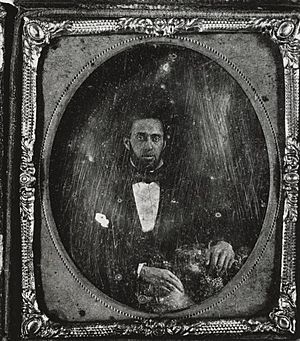
Ezekiel Gillespie, around 1850
1860
- Some states still required people to pay taxes to vote. These rules made it hard for poor white people to vote later on.
1866
- Wisconsin gave African American men the right to vote. This happened after Ezekiel Gillespie fought for his right to vote.
1868
- The Fourteenth Amendment to the United States Constitution was added. It said that all men born or naturalized in the U.S. were citizens. This was a big step for future voting rights.
- November 3: Voters in Iowa approved the right for African American men to vote.
1869
- Women in Wyoming gained equal voting rights.
New Rights and New Challenges (1870s)
1870
- The Fifteenth Amendment to the United States Constitution was added. It said states could not stop people from voting because of their "race, color, or previous condition of servitude" (meaning if they had been enslaved).
- However, after this, many former Confederate states passed "Jim Crow laws". These laws used things like poll taxes (a fee to vote), literacy tests (tests to read and write), and grandfather clauses (rules that let people vote only if their grandfathers had voted) to stop African Americans and poor white people from voting.
- The Supreme Court often allowed these unfair laws at first.
- Women in Utah gained the right to vote.
1875
- The Supreme Court case Minor v. Happersett decided that voting was not a right of citizenship. This meant women did not automatically have the right to vote.
1876
- The Supreme Court decided that Native Americans were not citizens and could not vote.
- Virginia changed its state constitution to require paying a poll tax to vote.
More Changes and Losses (1880s)
1882
- The Chinese Exclusion Act stopped Chinese Americans from voting and becoming citizens.
- Virginia removed the poll tax rule from its constitution.
1883
- Women in Washington Territory gained the right to vote.
1887
- The Dawes Act gave citizenship to Native Americans who left their tribes. This made those men able to vote.
- Women in Washington lost their right to vote.
- Women in Utah lost their right to vote because of the Edmunds–Tucker Act.
- Women in Kansas gained the right to vote in city elections.
- Arizona, Montana, New Jersey, North Dakota, and South Dakota gave women some voting rights.
Women's Suffrage Grows (1890s)
1890
- The Indian Naturalization Act of 1890 allowed Native Americans to apply for citizenship.
1893
- Colorado gave women full voting rights.
1896
- Women in Utah regained their right to vote.
- Grandfather clauses were used in Louisiana to stop Black people from voting.
- Women in Idaho gained the right to vote.
1899
- In the territory of Hawaii, only men who spoke English or Hawaiian could vote. The territory couldn't make its own voting laws.
Voting Rights in the 20th Century
Early 1900s (1900s)
1901
- Alabama added a "cumulative poll tax" to its constitution. This meant people had to pay all poll taxes they owed since they turned 21 before they could vote.
1902
- Virginia brought back the poll tax as a requirement to vote.
Women's Suffrage Movement (1910s)
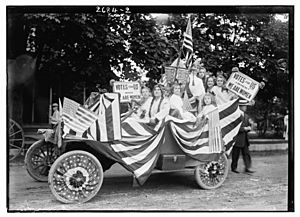
Suffragists in a parade
1910
- Washington state gave women back the right to vote.
1911
- Women in California gained the right to vote.
1912
- Women in Arizona, Kansas, and Oregon gained the right to vote.
1913
- The Seventeenth Amendment to the United States Constitution was added. It allowed people to directly elect their Senators, instead of state lawmakers choosing them.
- White and African American women in the Territory of Alaska gained the right to vote.
- Women in Illinois gained the right to vote in presidential elections.
1914
- Women in Nevada and Montana gained the right to vote.
1917
- Women in Arkansas gained the right to vote in primary elections.
- Women in Rhode Island gained the right to vote in presidential elections.
- Women in New York, Oklahoma, and South Dakota gained equal voting rights.
1918
- Women in Texas gained the right to vote in primary elections.
- Women in South Dakota gained the right to vote.
Women's Right to Vote and Native American Citizenship (1920s)
1920
- The Nineteenth Amendment to the United States Constitution was added. It guaranteed women the right to vote across the country!
- However, the same unfair rules (like poll taxes and literacy tests) that stopped non-white men from voting also stopped non-white women.
1923
- Texas passed a "white primary" law, meaning only white people could vote in primary elections.
1924
- The Indian Citizenship Act granted all Native Americans citizenship and the right to vote, no matter their tribal connection.
- Even with this law, some western states still stopped Native Americans from voting until 1948.
1925
- Alaska passed a literacy test designed to stop Alaska Native people from voting.
1926
- Georgia passed a cumulative poll tax rule.
1927
- The Supreme Court ruled in Nixon v. Herndon that white primary laws were against the Constitution.
Court Cases and Poll Taxes (1930s)
1932
- The Supreme Court case Nixon v. Condon struck down a Texas law that let political parties choose who could vote in their primary elections.
1933
- Poll taxes were ended in Pennsylvania.
1935
- The Supreme Court case Grovey v. Townsend decided that the Democratic Party, as a private group, could decide who could join and vote in their primary elections.
1937
- The Supreme Court case Breedlove v. Suttles decided that Georgia was allowed to have a poll tax.
More Citizenship and Voting Rights (1940s)
1943
- The Magnuson Act gave Chinese immigrants the right to become citizens and vote.
1944
- The Supreme Court case Smith v. Allwright overturned the Grovey v. Townsend decision. It said that primary elections were a key part of voting, and it was illegal to stop people from participating because of their race.
1948
- Arizona and New Mexico were among the last states to give full voting rights to Native Americans.
Expanding Rights and Removing Barriers (1950s)
1951
- The Supreme Court case Butler v. Thompson ruled that poll taxes were a settled law that Virginia could keep.
1952
- The McCarran Walter Act allowed all Americans of Asian background to vote.
1954
- Native Americans living on reservations in Maine gained the right to vote.
1958
- North Dakota removed a rule that required Native Americans to leave their tribes two years before an election to vote.
1959
- Alaska made its literacy test easier.
Major Civil Rights Era Changes (1960s)
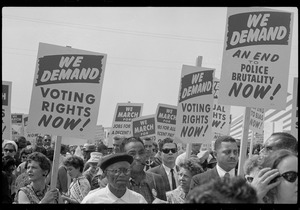
Marchers with signs at the March on Washington
1961
- The Twenty-third Amendment to the United States Constitution gave residents of Washington, D.C. the right to vote in U.S. Presidential Elections.
1962-1964
- The U.S. Supreme Court, led by Chief Justice Earl Warren, made important decisions. These decisions helped create the "one person, one vote" system across the U.S.
- In 1962, the Court ruled in Baker v. Carr that federal courts could hear cases about how voting districts were drawn.
- In 1964, the Court ruled in Wesberry v. Sanders that districts for the United States House of Representatives must have about the same number of people.
- In 1964, the Court ruled in Reynolds v. Sims that both parts of a state's lawmaking body must have districts with roughly equal populations.
1964
- The Twenty-fourth Amendment to the United States Constitution made it illegal to require poll taxes for voting in federal elections.
1965
- The Voting Rights Act of 1965 was passed. This very important law protected the right to vote for racial minorities. It also helped fix unfair election systems.
- The Supreme Court ruled in Harman v. Forssenius that poll taxes or similar fees could not be put on voters.
1966
- The Supreme Court ruled in Harper v. Virginia Board of Elections that states could not require poll taxes or wealth requirements for voting in state elections.
Lowering the Voting Age and More Protections (1970s)
1970
- Alaska stopped using literacy tests.
- Native Americans living on reservations in Colorado were first allowed to vote in the state.
1971
- The Twenty-sixth Amendment to the United States Constitution was added. It gave adults aged 18 through 21 the right to vote. This happened because many argued that if young people were old enough to fight in the Vietnam War, they should be old enough to vote.
1972
- The Supreme Court ruled in Dunn v. Blumstein that states could not require people to live in a place for a very long time before voting.
1973
- Local elections in Washington, D.C., like for Mayor and Councilmen, were brought back after many years.
1974
- The Supreme Court case Richardson v. Ramirez upheld California's rules that stopped people with felony convictions from voting.
- The Supreme Court case O'Brien v. Skinner upheld the rights of some people who were incarcerated to vote.
1975
- The Voting Rights Act was changed to give voters information in Native American languages and other non-English languages.
Extending Protections (1980s)
1982
- President Ronald Reagan signed a law that extended the Voting Rights Act for 25 more years.
1983
- Texas ended its rule that permanently stopped people with felony convictions from voting. Instead, they had to wait five years after finishing their sentence.
1985
- Texas changed the waiting period for people with felony convictions to two years.
1986
- The Uniformed and Overseas Citizens Absentee Voting Act gave U.S. Military members, Merchant Marine, and other citizens living overseas or on bases the right to vote.
Making Registration Easier (1990s)
1993
- The National Voter Registration Act of 1993 was passed. It aimed to make it easier for people to register to vote in more places.
1997
- Texas ended the two-year waiting period for people with felony convictions to get their voting rights back.
1998
- In Utah, people with a felony conviction could not vote while serving their sentence. After release, they could vote if convicted in Utah.
Voting Rights in the 21st Century
Restoring Rights (2000s)
2000
- Voters in U.S. territories like American Samoa, Guam, Puerto Rico, and the United States Virgin Islands were ruled unable to vote in presidential elections.
- Delaware ended permanent disenfranchisement for most people with felony convictions but added a five-year waiting period.
2001
- New Mexico ended permanent disenfranchisement for people with a felony conviction.
- Connecticut restored the rights of people serving felony probation.
2005
- Iowa restored the voting rights of people with felony convictions who had completed their prison sentences.
- Nebraska ended permanent disenfranchisement for people with felonies but added a five-year waiting period.
2006
- The Voting Rights Act of 1965 was extended for another 25 years by President George W. Bush.
- Utah changed its law and restored voting rights to all people who had completed their prison sentence for a felony.
- Rhode Island restored voting rights for people serving probation or parole for felonies.
2007
- Florida restored voting rights for most people with non-violent felony convictions.
2009
- Washington restored a person's right to vote if they had completed their sentences for a felony conviction.
Modern Challenges and Changes (2010s)
2010
- Voting rights in New Jersey were restored to people serving probation and parole for felonies.
2011
- Florida changed its felony voting rules. People with felony convictions had to wait five years after sentencing and apply to get their right to vote back.
- Iowa reversed its rule that allowed people with felony convictions to vote after completing their sentences.
- Texas passed a very strict voter ID law, but courts blocked it.
2013
- The Supreme Court ruled in Shelby County v. Holder that a part of the Voting Rights Act was unconstitutional. This part had required some states to get approval before changing their voting laws.
- Delaware removed the five-year waiting period for voters with a felony conviction.
- North Dakota passed a law that made it harder for Native American voters. It said voters without a permanent address could no longer vote.
2016
- California allowed people in county jail to vote.
- Maryland restored voting rights to people with felony convictions after they served their prison time.
2017
- Alabama published a list of crimes that could stop someone from voting.
- Wyoming restored the voting rights of people with non-violent felony convictions.
2018
- The Supreme Court upheld North Dakota's residential address law.
- Florida restored voting rights for many people with felony convictions, with some extra requirements.
- People with a felony conviction in Louisiana who had not been in jail for five years (including probation or parole) could vote.
- New York allowed people on parole to vote.
2019
- People convicted of a felony could vote in Nevada after release from prison.
- Citizens on parole could vote in Colorado.
- People convicted of a felony could vote in Oklahoma after serving their full sentence, including parole.
Recent Developments (2020s)
2020
- California restored voting rights to citizens serving parole.
- Washington, D.C. passed a law to allow people with felony convictions who are incarcerated to vote.
- People with a felony conviction in Iowa had their right to vote restored with some rules, and they had to have completed their sentence.
- People with a felony conviction in New Jersey could vote after release from prison. Citizens on parole or probation could also vote.
- North Dakota agreed with the Spirit Lake Nation and the Standing Rock Sioux to accept tribal addresses as valid for voting.
2021
- A Supreme Court ruling on Brnovich v. Democratic National Committee removed more parts of the Voting Rights Act.
- Texas passed new laws that made state election rules stricter and limited how local areas could expand voting options.
|

All content from Kiddle encyclopedia articles (including the article images and facts) can be freely used under Attribution-ShareAlike license, unless stated otherwise. Cite this article:
Timeline of voting rights in the United States Facts for Kids. Kiddle Encyclopedia.

